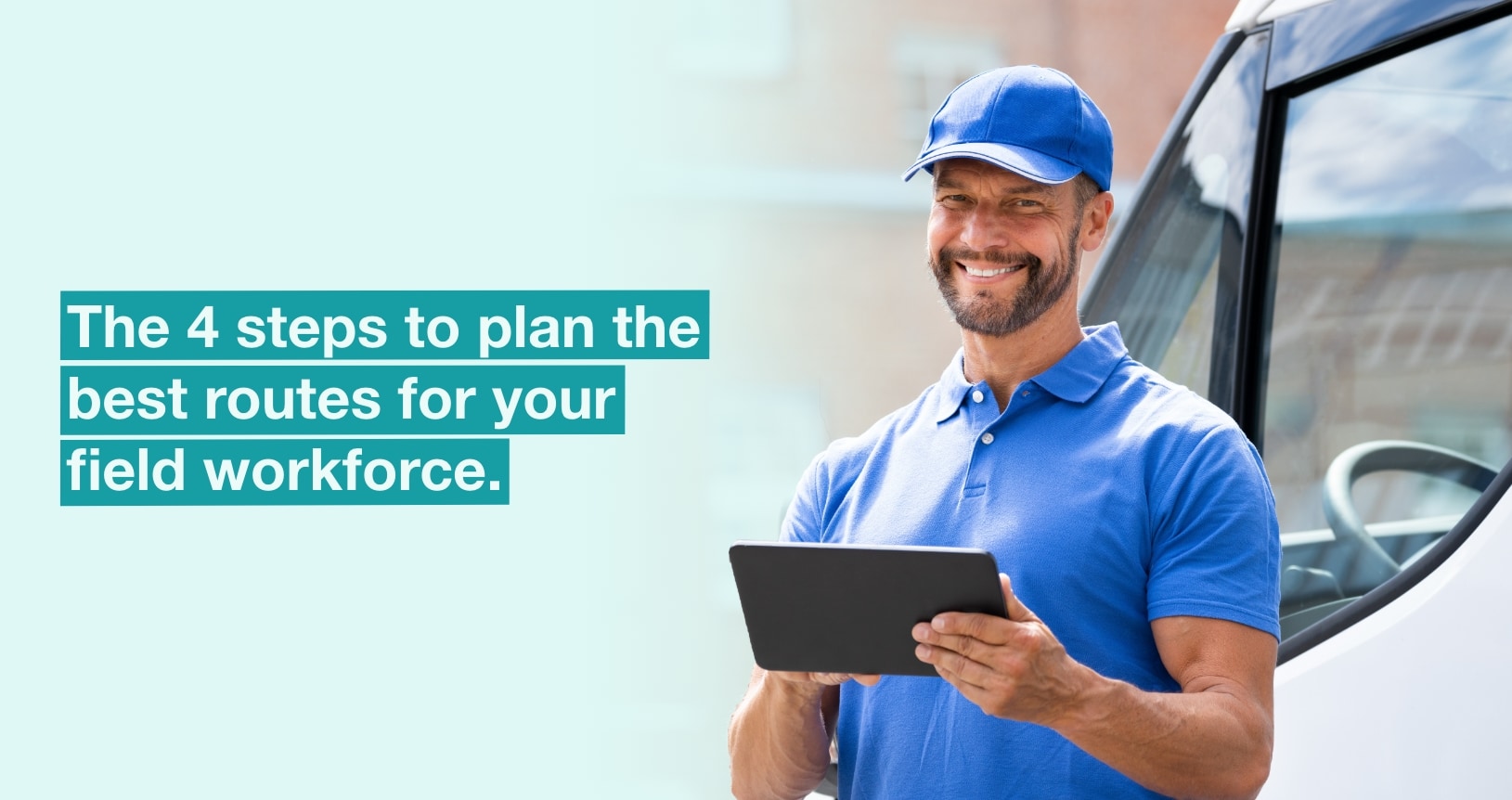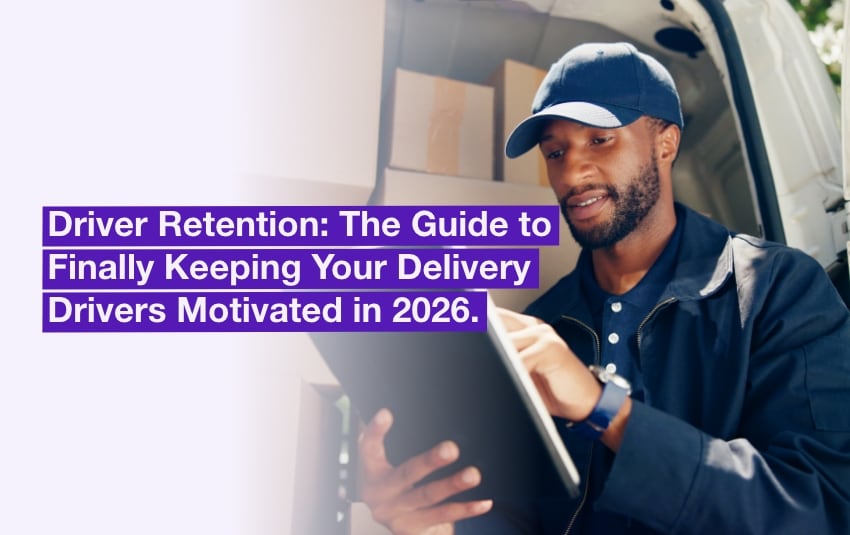The 4 steps to plan the best routes

Blog > Field Service > The 4 steps to plan the best routes
The 4 steps to plan the best routes
Published on 25 May 2023 • Reading time: 9 min read
It’s essential to plan efficient routes for sales representatives and other workers who have to make many appointments in the field: bailiffs, inspectors, repair technicians, etc. It allows them to optimize their trips and therefore their time and resources.
The result is additional sales or work orders opportunities, better productivity and faster achievement of objectives.
In this article, we will guide you through four key steps to determining a successful route to multiple destinations:
- Choose the type of route that is right for your business
- Select the data adapted to your trips and routes
- Choose the right tools to plan and optimize your routes
- Complete and connect your route plans
An effective planning of routes makes life easier for field workers. It optimises the resources and trips of field teams. Successful route plans improve productivity and make it easier to achieve objectives.
1. Choose the type of route that is right for your business
The first step in developing an effective multi stop route plan is to determine the type of routes that best suits your business.
This involves identifying the criteria that are relevant to the scheduling of your appointments. These criteria differ depending on your function and your objectives.
Criteria for selecting your route plans
You may need to organize your routes according to:
The priority level of your appointments
The level of emergency given to your appointments varies according to your job. A salesperson may wish to prioritize a potential sale or an important client. Bailiffs or other legal experts will have to take into account the legal constraints.
In more technical professions, more attention will be paid to the blocking or potentially dangerous nature of the equipment and facilities concerned.
Available resources (vehicle fleet, workforce, etc.)
This approach takes into account the human and technical resources at your disposal. Not all tasks or geographical areas can always be visited by the same people. In the same way, certain routes require the use of company vehicles or adequate equipment, which must be available at the time of the visit or field work.
The geographic location of your customers and prospects
This is the most common criterion used by sales people who are in charge of a large number of prospects and customers. It consists in grouping appointments by geographical areas, in order to minimize travel and optimize time in the field.
But other traveling professions with a large geographical area may also have a great interest in retaining this criterion as a priority.
Types of routes available
To cover these geographical areas, there are at least 3 main types of routes possible:
The Petal Route
In this method, the area to be covered is divided into 16 petals for one month of work. The center of the petals corresponds to the place of work or home of the salesman, i.e. the worker starts and ends the route at this address. The salesperson or field worker must cover the distance of one petal per day, starting from the furthest point, which is a maximum of 1.5 hours away, and return to the starting point in the evening. With one day of work at home per week, the worker or freelancer concerned completes his or her visit plan within the other 16 working days of the month. This organization is not very flexible with only one day per month for each petal.
The Cloverleaf-shaped Route
The method of the cloverleaf-shaped route is the same as for the petal route, but with a smaller area. There are 4 sectors instead of 16. The customers must be equally assigned between these 4 areas. One day per week is also devoted to remote prospecting and administrative tasks. Each other day is dedicated to visits in 1 of the 4 sectors. Over a week, it is thus possible to meet customers in each of these 4 sectors, without traveling too many kilometers per day.
The Spiral-shaped Route
The spiral-shaped route can be used when the geographical area is very large. By moving in a spiral from his home or office, the sales representative or mobile professional can limit the number of kilometers traveled: he goes from the nearest appointment to the farthest.
He can also move in a zigzag path, following a central axis towards the most distant customer. On his way, he will be able to make appointments with his prospects and customers, located on the left and right of this central axis.
These route plans are of course hypothetical and may vary over time depending on your business. And if you decide to use a route optimization software, you won’t need to choose the shape of your route. This will be discussed in a third part.
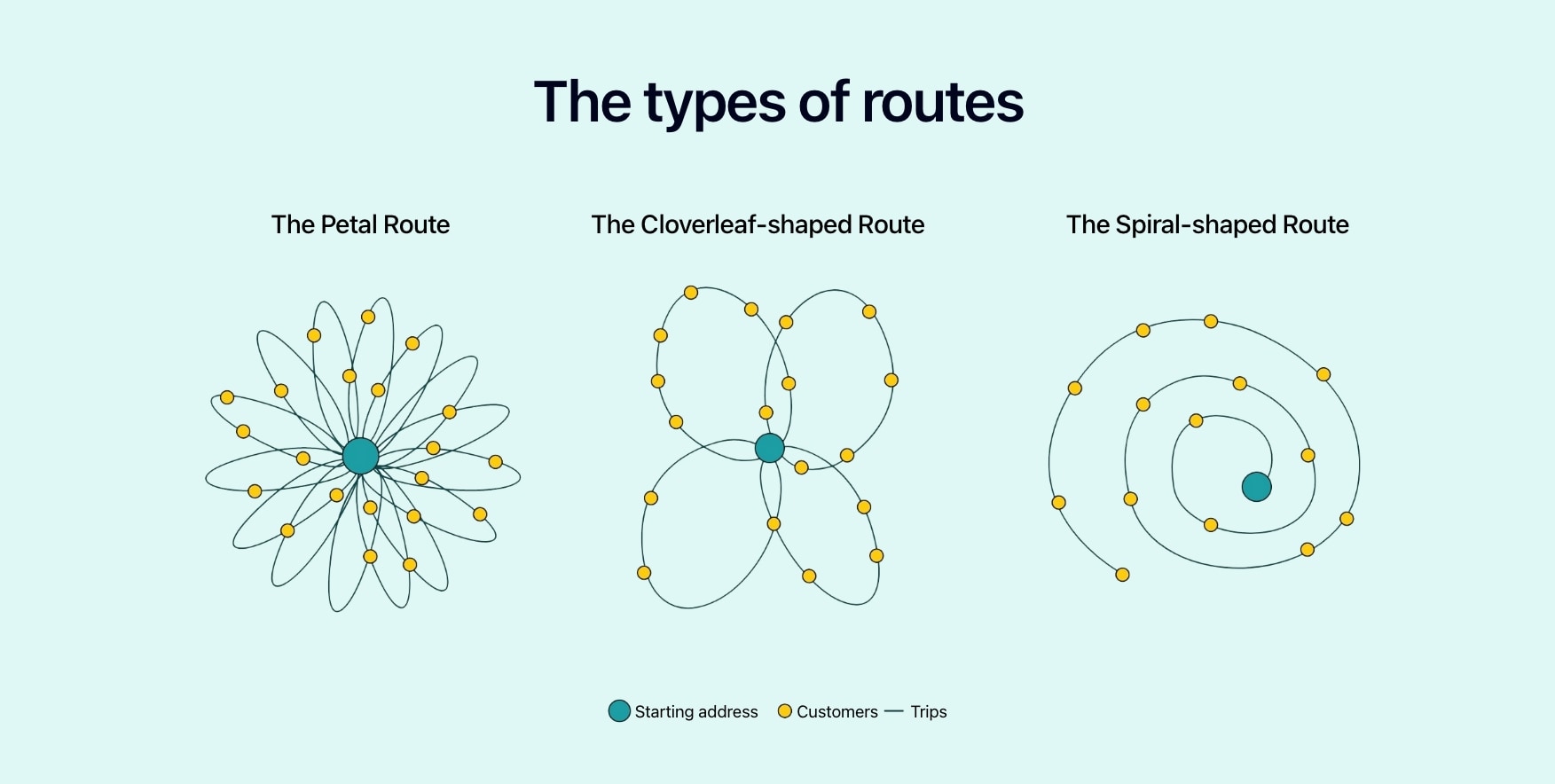
The 3 main types of routes.
2. Select the data adapted to your trips and routes
Once you have chosen the type of route that is right for you, the next step is to select the relevant data for your routes and trips.
You can use a variety of sources to get this information, such as your customer database, your customer relationship management (CRM) system, online scheduling tools, or even mobile applications dedicated to route management.
You will also need to ensure that this data is kept up to date.
This includes information about your customers, appointment times, but also the specific constraints related to each visit.
Complete customer details
You will of course need the name of the client, the date, time and address of the appointment.
But depending on the circumstances and clients, it may also be relevant to collect:
- Your client’s or prospect’s phone number and email address, to contact them if needed.
- Their visit preferences, specific times, break times, etc.
- Specific directions for entry to the site.
These instructions will allow you to better plan your routes, avoiding missed appointments or late arrivals.
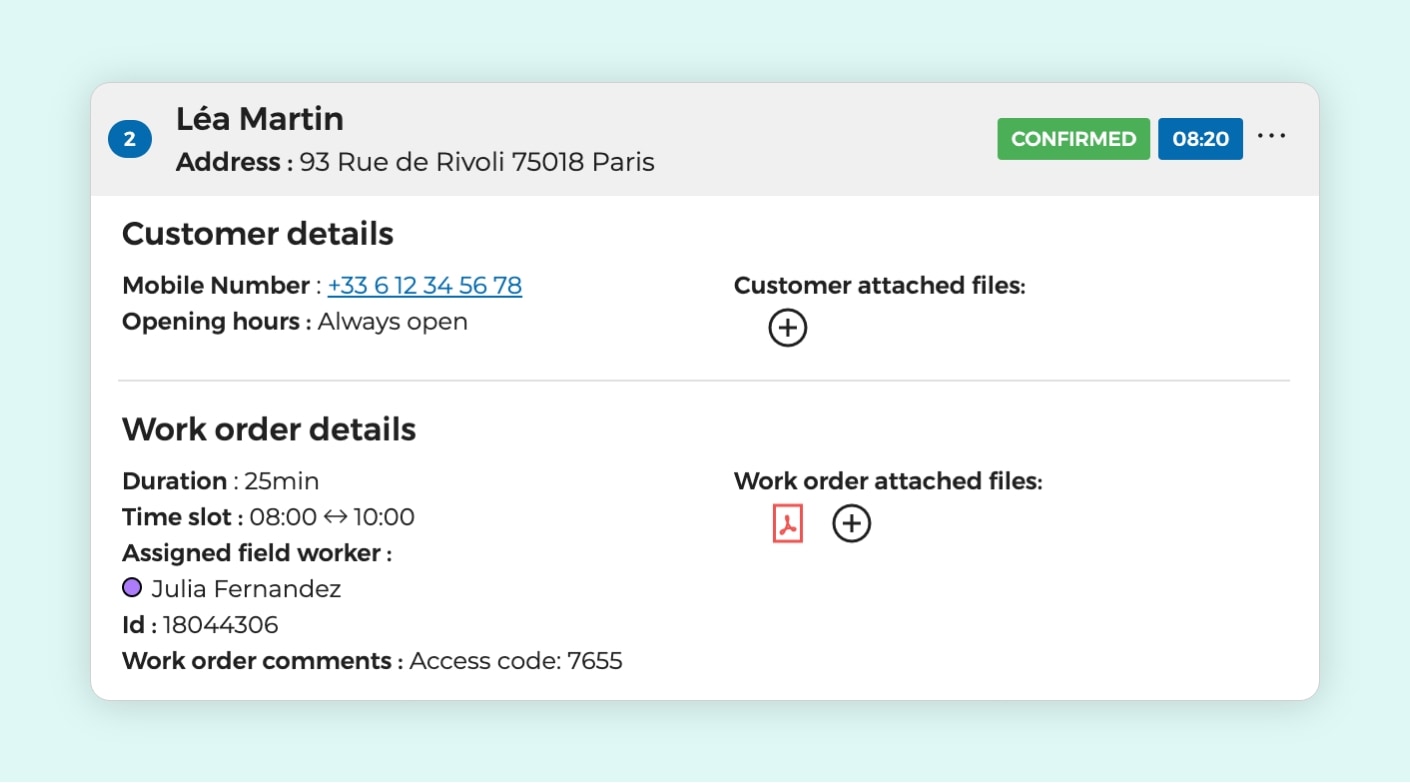
The complete customer details on AntsRoute.
History and objectives of customer appointments
It’s recommended that you track and record past interactions with your customers, such as previous appointments, orders or problems solved. With this information in mind, you will be more efficient during your visits and build a stronger and more reliable relationship with your customers.
We also invite you to indicate the objectives of your appointments and to classify your clients according to their importance, their potential or the level of emergency of your appointments. This way, you will be able to prioritize and focus on clients that need more attention or have a higher level of emergency. This will allow you to devote more time and resources to key clients at the right time.
Information on competition and customer activity
To achieve an additional level of customization in your appointments, it may be wise to collect information on your competitors in the targeted geographical area. As a salesperson, you will be one step ahead in your market positioning and will be more insightful in your sales pitch.
In the same way, if you are targeting new prospects, don’t hesitate to collect information about their industry, specific needs, key contacts or sales opportunities. This will help you identify the most promising prospects and tailor your prospecting strategies.
Of course, this does not apply to all professions. A bailiff or an inspector does not really have any competition. But it will still allow you to better understand the problems of your interlocutors.
The data you need will vary depending on your industry and your specific objectives. But by identifying and integrating the data that is relevant to your business and your customers, you can customize your approach and optimize your routes accordingly, saving time and increasing efficiency.

Gathering information enables you to better understand the issues faced by your contacts.
3. Choose the right tools to plan and optimize your routes
Once you have the necessary data, it’s time to choose the right tools to plan and optimize your routes. Fortunately, there are many software solutions available on the market today that can help you with this task.
We invite you to read our dedicated article on tools and software to get optimized multiple stop routes according to your specific needs.
Understand the limits of spreadsheets for the building of your route plans
Many companies still rely on spreadsheets like Excel or Google Sheet.
They allow you to record and connect a large amount of data, such as appointment locations and dates, contact details, etc.
But if you have to:
- multiply data cross-referencing (emergencies, preferences, available vehicle, etc.),
- integrate last-minute contingencies (canceled appointments, traffic jams, etc.),
- or simply optimize your trips according to the location and time of your appointments.
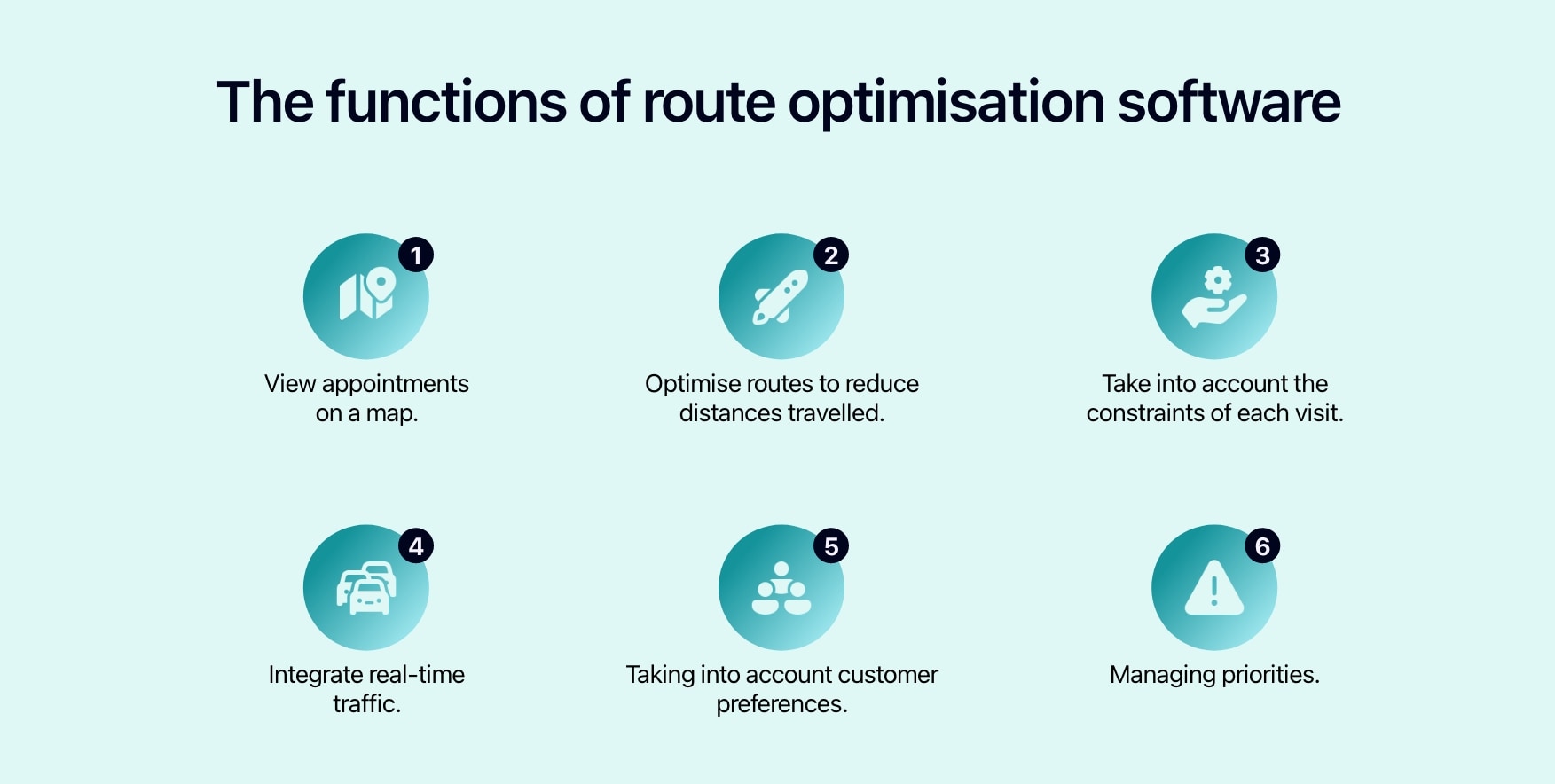
The main functions of route optimisation software.
Choose a route optimization software
Among the many software solutions available on the market, route planning tools allow you to:
- display your appointments on a map,
- automatically optimize the routes to reduce the distances traveled,
- and take into account the constraints of each visit.
Some tools even offer advanced features such as :
- integration of real-time traffic,
- taking into account the preferences of your customers,
- or priority management.
A route optimization software like AntsRoute calculates for you the best possible trip scenarios, according to the options you have defined (priority level, available resources, geographical location).
In a few minutes, the system provides you with a customized route plan, available on a mobile app that can be connected to Waze or Google Maps. In case of unexpected changes (replanning of appointments, unexpected events on the road, etc.), the multiple stop routes are automatically recalculated. You can also integrate all your visit reports, specific customer information and directly plan your next appointments.
Switching to route optimization software is not compulsory, but it will save you many kilometers and hours of planning. This means real peace of mind!
But not all software is suited to your specific needs.
When choosing your software, make sure that:
- that it takes your specific needs into account,
- that the interface is user-friendly enough, to be able to use it easily and permanently. There is nothing worse than a software that puts you off from the first time you use it!
- and that it allows synchronization with the other tools you already use, so that you don’t have to re-enter everything.

The AntsRoute route optimisation software.
4. Complete and connect your route plans
The final step is to complete and connect your route plans.
This involves taking into account other factors that may influence your work schedule, such as:
- corporate meetings,
- travel to and from work,
- preparation time or time slots dedicated to prospecting.
To do this, you’ll need to be able to connect your calendar to your route planning tool.
In addition, consider synchronizing your route plans with your other management tools, such as your CRM or sales tracking application. This will give you a global view of your activities and enable you to better coordinate your actions.
If you’re working with Excel or Google Sheet, there’s no need to give up. You can import your data into route optimization software. We explain how to do this in our dedicated article.
The route planning is an essential task for most mobile professions, such as sales representatives, bailiffs, inspectors and home care nurses.
By following the four steps described in this article, you’ll be able to build a successful route plan.
Choose the type of route that suits you, select the right data, choose the right tools to plan and optimize your routes, then complete and connect your route plans.
By putting these tips into practice, you’ll be able to maximize your efficiency, save time and achieve your objectives more quickly. And if you’d like to opt for route optimization software, our teams are at your disposal for a free demo and trial.
Free 7-day trial | No credit card required
Contenu
- 1. Choose the type of route that is right for your business
- Criteria for selecting your route plans
- The priority level of your appointments
- Available resources (vehicle fleet, workforce, etc.)
- The geographic location of your customers and prospects
- Types of routes available
- The Petal Route
- The Cloverleaf-shaped Route
- The Spiral-shaped Route
- 2. Select the data adapted to your trips and routes
- Complete customer details
- History and objectives of customer appointments
- Information on competition and customer activity
- 3. Choose the right tools to plan and optimize your routes
- Understand the limits of spreadsheets for the building of your route plans
- Choose a route optimization software
- 4. Complete and connect your route plans


